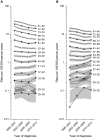The Changing Face of Noncardia Gastric Cancer Incidence Among US Non-Hispanic Whites
- PMID: 29361173
- PMCID: PMC6005150
- DOI: 10.1093/jnci/djx262
The Changing Face of Noncardia Gastric Cancer Incidence Among US Non-Hispanic Whites
Abstract
Background: The initial step for noncardia gastric carcinogenesis is atrophic gastritis, driven by either Helicobacter pylori infection or autoimmunity. In recent decades, the prevalence rates of these two major causes declined and increased, respectively, with changes in Western lifestyles. We therefore assessed gastric cancer incidence trends for US race/ethnic groups, 1995-2013.
Methods: Age-standardized rates (ASRs) from 45 North American Association of Central Cancer Tumor Registries were summarized by estimated annual percentage change (EAPC) and 95% confidence intervals (CIs). Age period cohort models supplemented standard descriptive techniques and projected future trends.
Results: There were 137 447 noncardia cancers in 4.4 billion person-years of observation. Among non-Hispanic whites, the ASR was 2.2 per 100 000 person-years, with an EAPC of -2.3% (95% CI = -2.0% to -2.6%). Notwithstanding this overall decline, EAPCs rose 1.3% (95% CI = 0.6% to 2.1%) for persons younger than age 50 years and fell -2.6% (95% CI = -2.4% to -2.9%) for older individuals. These converging trends manifested a birth cohort effect more pronounced among women than men, with incidence among women born in 1983 twofold (95% CI = 1.1-fold to 3.6-fold) greater than those born in 1951. Age interaction was also statistically significant among Hispanic whites, with slightly increasing vs decreasing EAPCs for younger and older individuals, respectively. Incidence declined regardless of age for other races. Current trends foreshadow expected reversals in both falling incidence and male predominance among non-Hispanic whites.
Conclusions: Dysbiosis of the gastric microbiome associated with modern living conditions may be increasing risk of autoimmune gastritis and consequent noncardia cancer. The changing face by age and sex of gastric cancer warrants analytical studies to identify potential causal mechanisms.
Figures


Comment in
-
A New Gastric Cancer Among Us.J Natl Cancer Inst. 2018 Jun 1;110(6):549-550. doi: 10.1093/jnci/djx279. J Natl Cancer Inst. 2018. PMID: 29361121 Free PMC article. No abstract available.
References
-
- Lagergren J, Smyth E, Cunningham D, et al. Oesophageal cancer. Lancet. In press. - PubMed
-
- Correa P. Gastric cancer: Overview. Gastroenterol Clin North Am. 2013;42(2):211–217.http://dx.doi.org/10.1016/j.gtc.2013.01.002 - DOI - PMC - PubMed
-
- Strickland RG. The Sydney System: Auto-immune gastritis. J Gastroenterol Hepatol. 1991;6(3):238–243.http://dx.doi.org/10.1111/j.1440-1746.1991.tb01471.x - DOI - PubMed
-
- Rugge M, Genta RM, Di Mario F, et al. Gastric cancer as preventable disease. Clin Gastroenterol Hepatol. 2017;15(12):1833–1843. - PubMed
-
- Blaser MJ, Falkow S.. What are the consequences of the disappearing human microbiota? Nat Rev Microbiol. 2009;7(12):887–894.http://dx.doi.org/10.1038/nrmicro2245 - DOI - PMC - PubMed
Publication types
MeSH terms
LinkOut - more resources
Full Text Sources
Other Literature Sources
Medical
Molecular Biology Databases

